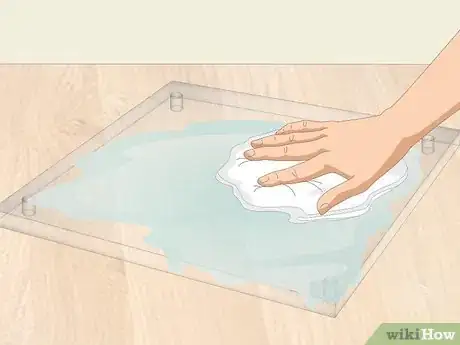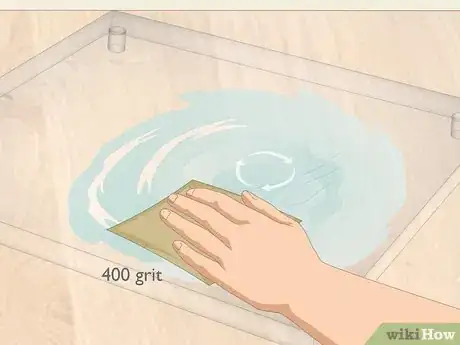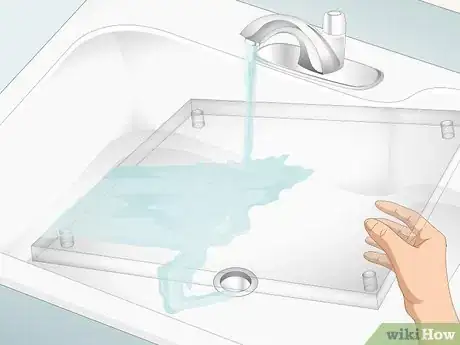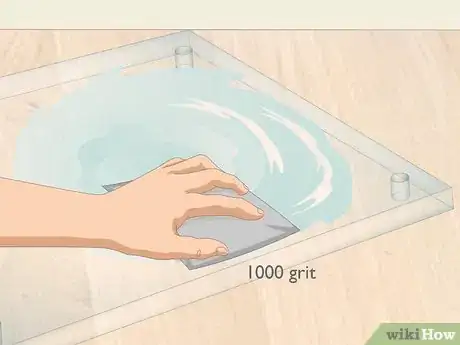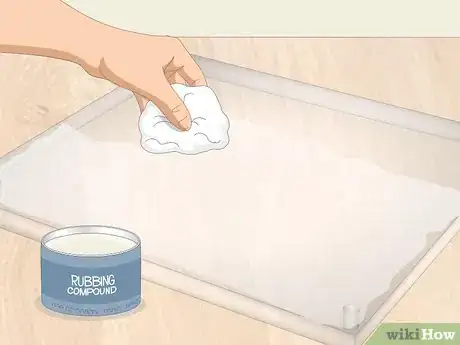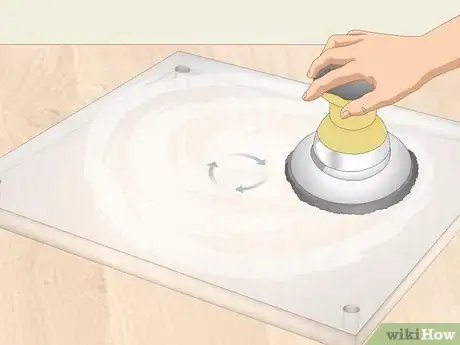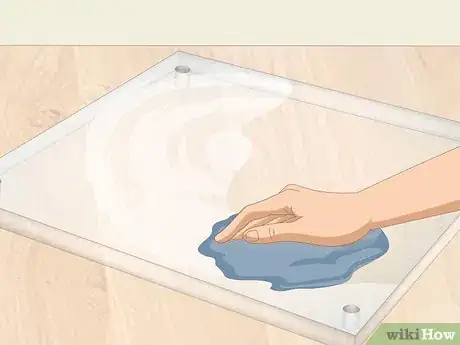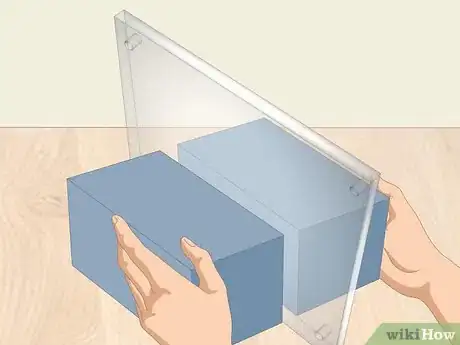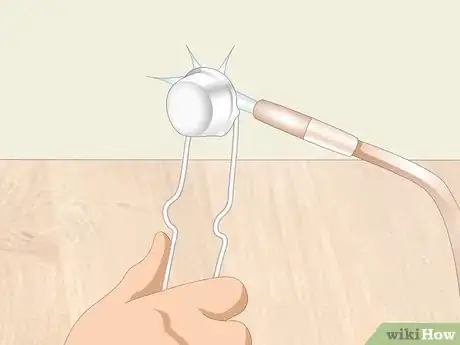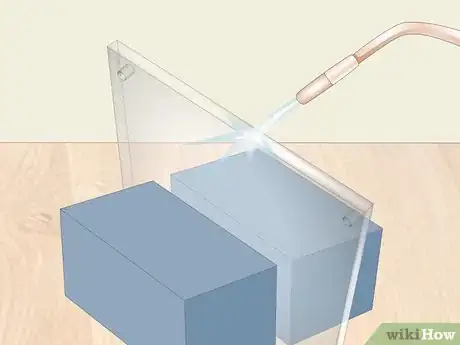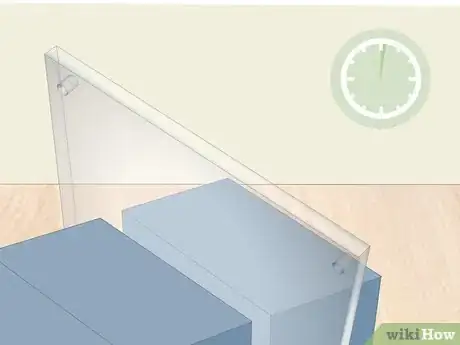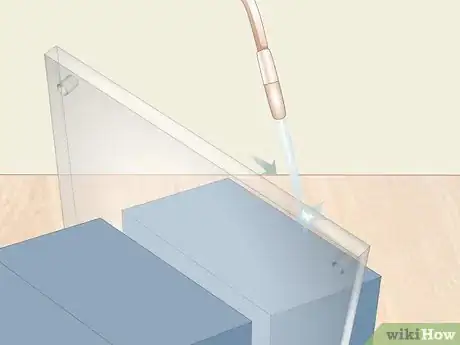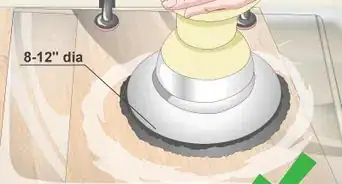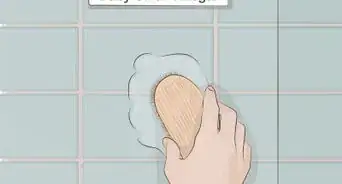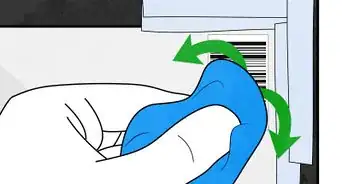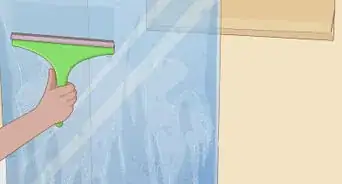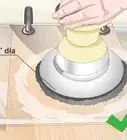This article was co-authored by Claudia & Angelo Zimmermann and by wikiHow staff writer, Hannah Madden. Claudia and Angelo Zimmermann are the founders of Everneat, an Eco-Friendly Cleaning Service based in New York City and in Connecticut. They are also the founders of Clean Code, a DIY 100% natural cleaning product line.
There are 12 references cited in this article, which can be found at the bottom of the page.
This article has been viewed 17,349 times.
Plexiglass is a handy and cost-effective substitute for real glass. But unlike real glass, plexiglass' relatively soft material is prone to streaks and scratches. Thankfully, those imperfections don't have to be permanent. We'll show you how to remove scratches and polish the faces and sides of a pane plexiglass. Let's get that pane sparkling again!
Things You Should Know
- Drop a spoonful of water over any scratches. Then gently rub sandpaper in a circular motion over the damaged area.
- Polish the surface with a cloth and some buffing compound. Then, use a low-speed rotary polisher to work in the compound.
- Pass a propane torch quickly over the edges of the plexiglass to smooth the sides of the pane
Steps
Removing Surface Scratches
-
1Clean the surface with water and a clean cloth. It is important to remove and dirt and large debris that might be on the surface of your plexiglass. Use a clean and damp washcloth or towel to gently wipe the entire surface of your plexiglass.[1]
- Cleaning your plexiglass will also help you see what is actually scratched and what was just dirt.
-
2Pour a spoonful of water over the scratches. It is important to be gentle when polishing your plexiglass so that you don’t damage it further. Pouring some water over the scratched area before you start using sandpaper will create a buffer and protect your plexiglass. You don’t need to pour a ton of water over the area, but it should cover the entirety of wherever you are polishing.[2]
- You can keep a bucket or bowl of water near you in case you need more throughout this process.
Advertisement -
3Sand the area with a 400 grit sandpaper in a circular motion until it is smooth. Rub your sandpaper in a circular motion on top of the scratches, applying gentle pressure. You should do this for about 1 minute and then check if the surface feels smooth.[3]
- You can find sandpaper at most home improvement or hardware stores.
-
4Rinse the area with water. The sandpaper may have made the surface of your plexiglass look cloudy. Rinse it with water to see how well your sandpaper worked and to clean your surface off.
-
5Use a smaller grit sandpaper if your plexiglass does not feel smooth. If you plexiglass still feels like it is scratched, put more water on it and use a smaller grit sandpaper in a circular motion. Your sandpaper can go up to 1000 grit, and you can do this 2 to 3 more times using a finer grit each time.[4]
Tip: Your plexiglass will always look matte and cloudy after using sandpaper. Use your hands to feel for smoothness rather than looking for it.
Polishing the Faces
-
1Spread a light film of buffing compound over the plexiglass. A buffing compound will help to fill in any scratches that are left and make your plexiglass look shiny. Spread a thin layer of your buffing compound over the area that has been sandpapered with a cloth or towel. Spread it in a circular motion, similar to how you used the sandpaper. Start with a dime sized drop and add more if you need to.[5]
- You can buy buffing compounds at most hardware stores.
-
2Use a rotary polisher on the lowest speed in a circular motion. Buff in your buffing compound with a rotary polisher that is set to the lowest speed. Apply a slight amount of pressure so that you don’t damage your plexiglass. Use your polisher until you can’t see the layer of buffing compound on top of the plexiglass anymore. This usually takes 2 to 3 minutes.[6]
Tip: Most hardware stores rent out rotary polishers by the hour or by the day. If you don’t have a rotary polisher, you can also use a dremel tool with a buffing pad attached to it.[7]
-
3Wipe the area you polished off with a dry cloth. Once your buffing compound has been rubbed into the area, you can wipe off of your plexiglass with a clean, dry cloth. Gently wipe your plexiglass until it looks shiny and free of streaks or marks.[8]
Polishing the Edges
-
1Set your plexiglass on a foam block with one of the edges facing upwards. It will be much easier to work on the edge of your plexiglass piece if it is raised and facing you. Set up a foam block on a flat surface, like a table or workbench, and place your plexiglass piece diagonally on the foam block with one edge upward and facing you.[9]
- You can buy foam blocks at most home improvement stores.
-
2Turn on your propane torch by opening the chamber and lighting the gas. To ignite your propane torch, open up the chamber near the top of the torch so that gas is coming out. Then, take a lighter and light the gases. Always use caution when you use a propane torch.[10]
- Many hardware stores will rent out propane torches by the day or even by the hour.
-
3Pass the torch over the edge of the plexiglass. Holding your torch steady, pass the flame quickly over the edge that you are polishing. Don’t let your flame linger, or you could melt the glass. Passing your flame over the edge should take 2 seconds at the most.[11]
-
4Let the edge cool for 1 minute to see how it looks. You will be able to tell if the edge is smooth after it is cool. Don’t touch or pass your flame over the edge again for another minute to give the plexiglass a chance to settle and harden again.[12]
Warning: Your plexiglass will be very hot, so use caution and don’t touch or handle it until you are sure it is cool.
-
5Pass your torch over the edge again if it is not smooth. If your plexiglass is not smooth after one pass of your torch, you can do it 2 to 3 more times until it is. Your plexiglass will look shiny and smooth once it is finished.[13]
Expert Q&A
Did you know you can get expert answers for this article?
Unlock expert answers by supporting wikiHow
-
QuestionHow do you clean plexiglass without scratching it?
 Claudia & Angelo ZimmermannClaudia and Angelo Zimmermann are the founders of Everneat, an Eco-Friendly Cleaning Service based in New York City and in Connecticut. They are also the founders of Clean Code, a DIY 100% natural cleaning product line.
Claudia & Angelo ZimmermannClaudia and Angelo Zimmermann are the founders of Everneat, an Eco-Friendly Cleaning Service based in New York City and in Connecticut. They are also the founders of Clean Code, a DIY 100% natural cleaning product line.
House Cleaning Professionals You want to remove any particles from the surface first, as plexiglass is delicate and very easy to scratch. Use a dry dust microfiber cloth to dust the surface very softly. This specialty cloth attracts dust like a magnet. Then, fold your glass microfiber cloth in 4 and spray glass cleaner directly to the surface. Wipe it down and then remove any marks or streaks with the dry side of your cloth.
You want to remove any particles from the surface first, as plexiglass is delicate and very easy to scratch. Use a dry dust microfiber cloth to dust the surface very softly. This specialty cloth attracts dust like a magnet. Then, fold your glass microfiber cloth in 4 and spray glass cleaner directly to the surface. Wipe it down and then remove any marks or streaks with the dry side of your cloth.
Warnings
- Propane torches should be handled with caution. Always read the instruction manual before using a tool like this and keep a fire extinguisher near you just in case.⧼thumbs_response⧽
Things You’ll Need
Removing Surface Scratches with Sandpaper
- 2 to 3 pieces of fine sandpaper
Polishing to a Shine with a Rotary Polisher
- Buffing component
- Rotary polisher
- Washcloth or towel
Polishing the Edges with a Propane Torch
- Propane torch
- Lighter
- Foam block
References
- ↑ https://www.bobvila.com/articles/how-to-clean-plexiglass/
- ↑ https://www.youtube.com/watch?v=PXuSiLmgMKE&feature=youtu.be&t=192
- ↑ https://www.youtube.com/watch?v=PXuSiLmgMKE&feature=youtu.be&t=216
- ↑ https://www.bobvila.com/articles/how-to-clean-plexiglass/
- ↑ https://www.youtube.com/watch?v=TpZBpwauAUk&feature=youtu.be&t=109
- ↑ https://www.youtube.com/watch?v=8aJC_0k27JE&feature=youtu.be&t=147
- ↑ https://www.youtube.com/watch?v=9Sfyb986Atg&feature=youtu.be&t=158
- ↑ https://www.youtube.com/watch?v=TpZBpwauAUk&feature=youtu.be&t=163
- ↑ https://www.youtube.com/watch?v=uEid6hAQxFU&feature=youtu.be&t=165
